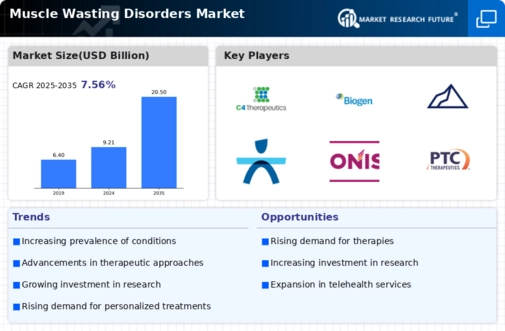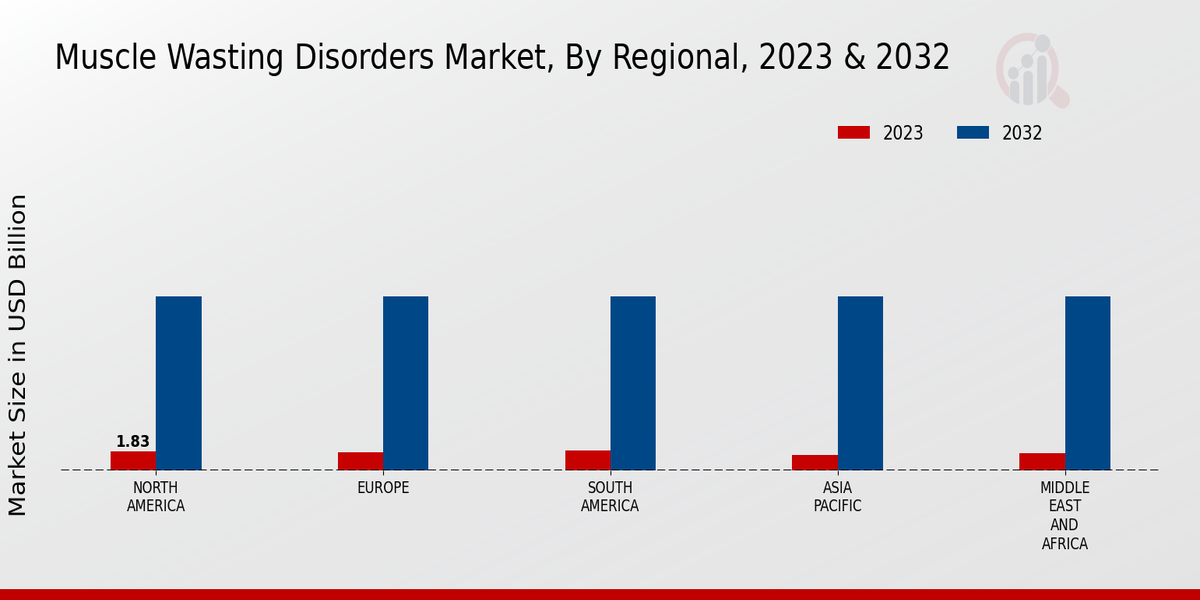Market Growth Projections
The Global Muscle Wasting Disorders Market Industry is poised for substantial growth, with projections indicating a market value of 9.21 USD Billion in 2024 and an anticipated increase to 20.5 USD Billion by 2035. This growth trajectory reflects a compound annual growth rate (CAGR) of 7.56% from 2025 to 2035. The expanding market is driven by various factors, including the rising prevalence of muscle wasting disorders, advancements in treatment modalities, and increased awareness among healthcare professionals and patients. As the industry evolves, stakeholders must remain vigilant to capitalize on emerging opportunities and address the challenges associated with muscle wasting disorders.
Increased Awareness and Education
Growing awareness and education regarding muscle wasting disorders among healthcare professionals and the general public are vital drivers for the Global Muscle Wasting Disorders Market Industry. Initiatives aimed at educating clinicians about early diagnosis and management strategies are becoming more prevalent. Furthermore, public health campaigns are emphasizing the importance of nutrition and exercise in preventing muscle loss. This heightened awareness is likely to lead to earlier interventions and increased demand for therapeutic options. As the market evolves, the focus on education and awareness will be instrumental in addressing the challenges posed by these disorders.
Advancements in Treatment Modalities
Innovations in treatment options for muscle wasting disorders are propelling the Global Muscle Wasting Disorders Market Industry forward. Recent developments in pharmacological therapies, nutritional supplements, and physical rehabilitation techniques have shown promise in managing these conditions. For example, new anabolic agents are being explored to counteract muscle loss effectively. These advancements not only enhance patient outcomes but also stimulate market growth as healthcare providers seek to adopt the latest evidence-based practices. As the market is expected to grow at a CAGR of 7.56% from 2025 to 2035, the continuous evolution of treatment modalities plays a crucial role in shaping the industry's future.
Aging Population and Longevity Trends
The global demographic shift towards an aging population is a significant factor influencing the Global Muscle Wasting Disorders Market Industry. As life expectancy increases, the incidence of age-related muscle wasting disorders, such as sarcopenia, is expected to rise. This trend is particularly evident in developed countries, where the proportion of individuals aged 65 and older is projected to grow substantially. By 2035, the market is anticipated to reach 20.5 USD Billion, driven by the need for effective management strategies for this vulnerable population. Consequently, the aging demographic is a critical market driver that necessitates targeted healthcare solutions.
Regulatory Support and Funding Initiatives
Support from regulatory bodies and increased funding for research into muscle wasting disorders are pivotal for the Global Muscle Wasting Disorders Market Industry. Governments and health organizations are recognizing the need to address these conditions, leading to enhanced funding for clinical trials and research initiatives. This support facilitates the development of new therapies and interventions, ultimately benefiting patients. As funding increases, the market is likely to experience accelerated growth, with stakeholders eager to invest in innovative solutions. The collaborative efforts between public and private sectors are essential for advancing the understanding and treatment of muscle wasting disorders.
Rising Prevalence of Muscle Wasting Disorders
The increasing incidence of muscle wasting disorders globally is a primary driver for the Global Muscle Wasting Disorders Market Industry. Conditions such as sarcopenia and cachexia are becoming more prevalent, particularly among aging populations. For instance, it is estimated that approximately 30% of older adults experience sarcopenia, which significantly impacts their quality of life. This growing demographic trend suggests a rising demand for effective treatments and interventions, contributing to the market's expansion. As the market is projected to reach 9.21 USD Billion in 2024, addressing these disorders is becoming increasingly critical for healthcare systems worldwide.



 Source: Primary Research, Secondary Research, MRFR Database and Analyst Review
Source: Primary Research, Secondary Research, MRFR Database and Analyst Review













